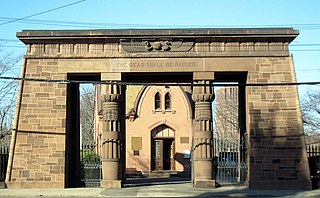
Grove Street Cemetery or Grove Street Burial Ground is a cemetery in New Haven, Connecticut, that is surrounded by the Yale University campus. It was organized in 1796 as the New Haven Burying Ground and incorporated in October 1797 to replace the crowded burial ground on the New Haven Green. The first private, nonprofit cemetery in the world, it was one of the earliest burial grounds to have a planned layout, with plots permanently owned by individual families, a structured arrangement of ornamental plantings, and paved and named streets and avenues. By introducing ideas like permanent memorials and the sanctity of the deceased body, the cemetery became "a real turning point... a whole redefinition of how people viewed death and dying", according to historian Peter Dobkin Hall. Many notable Yale and New Haven luminaries are buried in the Grove Street Cemetery, including 14 Yale presidents; nevertheless, it was not restricted to members of the upper class, and was open to all.

The New Haven Green is a 16-acre (65,000 m2) privately owned park and recreation area located in the downtown district of the city of New Haven, Connecticut. It comprises the central square of the nine-square settlement plan of the original Puritan colonists in New Haven, and was designed and surveyed by colonist John Brockett. Today the Green is bordered by the modern paved roads of College, Chapel, Church, and Elm streets. Temple Street bisects the Green into upper (northwest) and lower (southeast) halves.

The Yale Bowl Stadium is a college football stadium in the northeast United States, located in New Haven, Connecticut, on the border of West Haven, about 1½ miles west of the main campus of Yale University. The home of the American football team of the Yale Bulldogs of the Ivy League, it opened in 1914 with 70,896 seats; renovations have reduced its current capacity to 61,446.
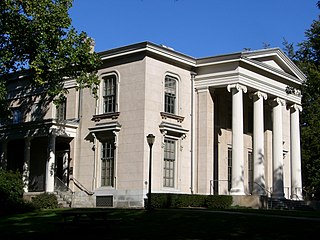
Hillhouse Avenue is a street in New Haven, Connecticut, famous for its many nineteenth century mansions, including the president's house at Yale University. Both Charles Dickens and Mark Twain have described it as "the most beautiful street in America." Much of the avenue is included in the Hillhouse Avenue Historic District, which extends to include houses on adjacent streets.

Russell Henry Chittenden was an American physiological chemist. He conducted pioneering research in the biochemistry of digestion and nutrition.

This is intended to be a complete list of the properties and districts on the National Register of Historic Places in Fairfield County, Connecticut, United States. The locations of National Register properties and districts for which the latitude and longitude coordinates are included below may be seen in an online map.

Connecticut Hall is a Georgian building on the Old Campus of Yale University. Completed in 1752, it was originally a student dormitory, a function it retained for 200 years. Part of the first floor became home to the Yale College Dean's Office after 1905, and the full building was converted to departmental offices in the mid-twentieth century. It is currently used by the Department of Philosophy, and its third story contains a room for meetings of the Yale Faculty of Arts & Sciences, the academic faculty of Yale College and the Graduate School.
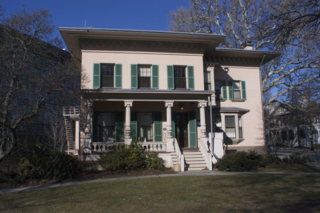
The James Dwight Dana House, also known as the Dana House, is a historic 19th-century Italianate house at 24 Hillhouse Avenue in New Haven, Connecticut, in the United States. This building, designed by New Haven architect Henry Austin, was the home of Yale University geology professor James Dwight Dana (1813–95). It was declared a National Historic Landmark in 1965 for its association with Dana, who produced the first published works emphasizing that the study of geology was a much broader discipline than the examination of individual rocks.

The Edward W. Morley House is a historic house and National Historic Landmark at 26 Westland Avenue in West Hartford, Connecticut. It is notable as the home of the scientist Edward W. Morley (1838–1923) from 1906 to 1923. Morley is famous for his collaboration with Albert A. Michelson on the Michelson–Morley experiment and for his work on the atomic weights of hydrogen and oxygen.

Marsh Hall, historically known as the Othniel C. Marsh House, is a historic house on Prospect Hill in New Haven, Connecticut. The property, which includes the house and a 6.8 acres (2.8 ha) grounds now known as Marsh Botanical Garden, was declared a National Historic Landmark in 1965. It was built in 1878 as the home of Othniel Marsh (1831–99), a leading 19th-century paleontologist, who occupied it until his death. The house is now owned by Yale University, and the building is occupied by the Yale School of Forestry and Environmental Studies.

The Lafayette B. Mendel House is an historic Italianate house at 18 Trumbull Street in New Haven, Connecticut. This building, designed by New Haven architect Henry Austin, was the home of Yale University physiology professor, Lafayette Benedict Mendel (1872–1935) from 1900–1924. It was declared a National Historic Landmark in 1976 for its association with Mendel, who discovered vitamins A and B, and greatly expanded knowledge of nutrition and food-related biochemistry. The building now houses a law firm.

The Howard Avenue Historic District is a 32-acre (13 ha) historic district in The Hill neighborhood of the city of New Haven, Connecticut. Extending along Howard Avenue between Minor Street and Interstate 95, it contains an unusually high concentration of well-preserved late 19th-century middle class vernacular architecture, reflecting the area's growth at that time. It was listed on the National Register of Historic Places in 1985.

Prospect Hill is a neighborhood of the city of New Haven, Connecticut located in the north central portion of the city, directly north of Downtown New Haven. The neighborhood contains residences, institutional buildings of Albertus Magnus University and a portion of the main campus of Yale University, including the Science Hill area, the Hillhouse Avenue area and the Yale Peabody Museum. The City of New Haven defines the neighborhood to be the region bounded by the town of Hamden in the north, Winchester Avenue in the west, Munson Street/Hillside Place/Prospect Street in the southwest, Trumbull Street in the south, and Whitney Avenue in the east. Prospect Street is the main thoroughfare through the neighborhood.
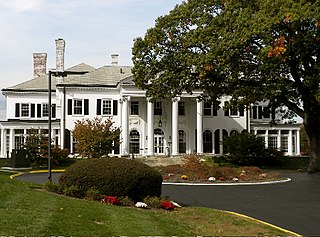
The Prospect Hill Historic District is an irregularly-shaped 185-acre (75 ha) historic district in New Haven, Connecticut. The district encompasses most of the residential portion of the Prospect Hill neighborhood.

This is a list of National Register of Historic Places listings in New Haven, Connecticut.
J. Frederick Kelly (1888–1947) was an American architect who has designed significant houses. Kelly was regarded as the leading architectural historian in Connecticut.
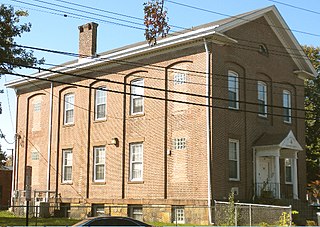
The Goffe Street Special School for Colored Children is an important landmark of African-American history at 106 Goffe Street in New Haven, Connecticut. The building, also known as Prince Hall Grand Lodge of Masons, was added to the National Register of Historic Places in 1979.
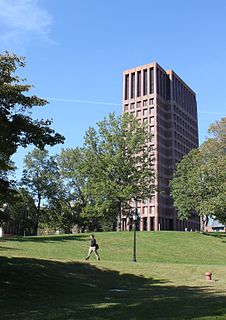
Science Hill is a planning precinct of the Yale University campus primarily devoted to physical and biological sciences. It is located in the Prospect Hill neighborhood of New Haven, Connecticut.

Steinbach Hall, also known as the John Pitkin Norton House, is a historic building on the campus of Yale University in New Haven, Connecticut, U.S..

For Horchow Hall in Dallas, Texas, see Morton H. Meyerson Symphony Center.





















